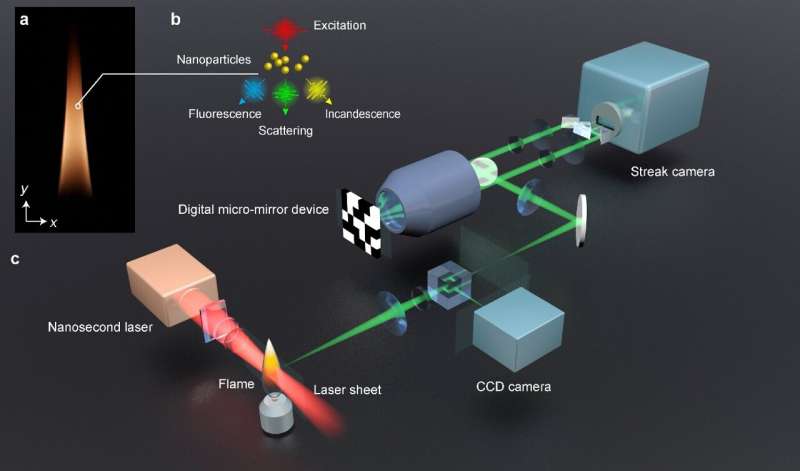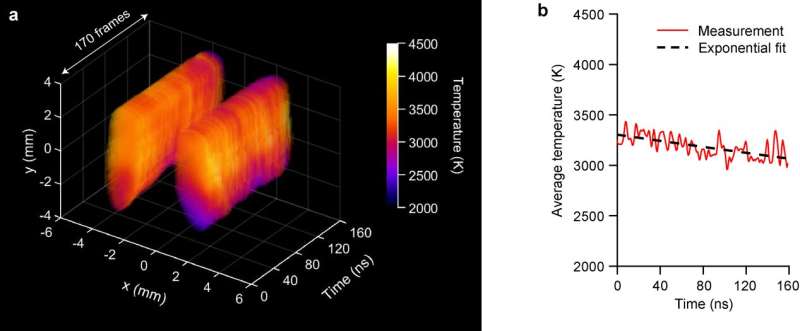
Burning hydrocarbon fuels produces nano-sized soot particles and Polycyclic Aromatic Hydrocarbons (PAH)—harmful emissions that impact our environment. The carbon-made particles make up 70% of our interstellar space, and black carbon particles from flames are exciting nanomaterials for electronic devices and sustainable energy applications—making their study important.
The lifetimes of soot and PAHs are extremely short (sub nanoseconds to hundreds of nanoseconds) in turbulent flames. Therefore, it requires ultrafast imaging approaches to resolve combustion both in space (2D/3D) and time.
The current state-of-the-art planar imaging systems are limited to just a few million frames per second. To extract 2D maps of flame species, they also require multiple consecutive laser pulses, causing undesired thermal issues. Furthermore, the traditional pump-probe ultrafast imaging methods can only capture the processes which are “repeatable” because several images of the same process are taken at different time instances to extract a complete picture of spatiotemporal dynamics.
Therefore, researchers in the field of combustion science have long awaited a tool that can overcome the limitations of the current systems.
In a new paper published in Light: Science & Applications, a team of scientists, led by Dr. Yogeshwar Nath Mishra, Dr. Peng Wang and Professor Lihong V. Wang, from California Institute of Technology and their collaborators from University of Gothenburg in Sweden, and Friedrich-Alexander University Erlangen in Germany, have developed the world’s fastest planar imaging camera: laser-sheet compressed ultrafast photography (LS-CUP).

Using LS-CUP, they have captured the entire movies of laser-flame dynamics at a record imaging speed of 12.5 billion frame per second (Gfps), which is at least three orders of magnitude higher than the current state-of-the-art systems. Using only one single laser pulse, LS-CUP enabled wide-field real-time imaging of laser-induced fluorescence from PAHs, elastic light scattering and laser-induced incandescence from soot particles.
Dr. Yogeshwar Nath Mishra, one of the leading authors of this paper said, “Laser sheet imaging is one of the most popular techniques for characterizing flows and combustion in two-dimension (2D) because it preferably resolves a plane in both time and space. Using LS-CUP, we can perform many exciting studies and ‘film’ fast chemical reactions and non-repeatable flame-laser interactions using a single laser pulse in real-time beyond the MHz imaging range.”
“We can combine it with pre-existing planar imaging methods for combustion research. Further, we can apply LS-CUP for real-time observation of hydrogen combustion, plasma-assisted combustion, and metal powder combustion—some of the recent hot topics in the field. Temperature is a crucial property in many thermodynamic systems, and to the best of our knowledge, we have reported its fastest wide-field measurements.”
Dr. Peng Wang, the other major contributor to this work, said, “LS-CUP is perfect: it is single-shot, only needs a single laser pulse, has a wide field-of-view, and can be easily adapted to observe all kinds of laser-induced signals over the entire lifetime of soot particles. We extracted critical parameters from the fast dynamics, such as fluorescence lifetimes of PAH molecules, soot nanoparticle sizes and cluster sizes, particle temperature, etc.”
“LS-CUP, in general, allows us to study extremely fast phenomena from a completely new and unique perspective. Reaching far beyond combustion research, the applications of our technique are extremely broad in physics, chemistry, biology and medicine, energy, and environmental research. The capability of capturing ultrafast phenomena represents an important metric of our human’s technology development, which is also driven by the curiosity and needs of scientists and engineers across various fields.”
More information: Yogeshwar Nath Mishra et al, Single-pulse real-time billion-frames-per-second planar imaging of ultrafast nanoparticle-laser dynamics and temperature in flames, Light: Science & Applications (2023). DOI: 10.1038/s41377-023-01095-5
Journal information: Light: Science & Applications
Provided by Chinese Academy of Sciences

